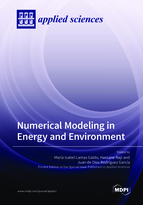Numerical Modeling in Energy and Environment
A special issue of Applied Sciences (ISSN 2076-3417). This special issue belongs to the section "Energy Science and Technology".
Deadline for manuscript submissions: closed (20 June 2022) | Viewed by 26120
Special Issue Editors
Interests: computational fluid dynamics; hydrodynamics
Special Issues, Collections and Topics in MDPI journals
Interests: thermal-fluid sciences & engineering; advanced heat/mass transfer; porous media; geo-mechanics; fluid mechanics (turbulence, modeling, simulation); computational fluid dynamics (CFD); numerical methods for multi-scale simulations (mesoscopic and macroscopic approaches, lattice Boltzmann methods, gaskinetic schemes); thermodynamics and heat transfer
Special Issue Information
Dear Colleagues,
Numerical methods have become too important in recent years. The evolution of computation has made it possible to create interesting tools to analyze problems. Besides, numerical models provide information not always achievable through experimental techniques.
Numerical models are applied to many fields. Between these, environment and energy constitute a constantly expanding topic.
This Special Issue seeks contributions that fit in one or more of the subjects listed below. Nevertheless, works not directly related to these shall also be considered in cases of particular interest to this Special Issue.
- Two- and three-dimensional modeling
- Numerical simulations
- Computational fluid dynamics
- Finite elements analyses
- Mathematical models
- Innovative modeling approaches
- Challenges in numerical models
- Advanced models
- New application areas
Dr. María Isabel Lamas Galdo
Prof. Dr. Hassane Naji
Dr. Juan de Dios Rodríguez García
Guest Editors
Manuscript Submission Information
Manuscripts should be submitted online at www.mdpi.com by registering and logging in to this website. Once you are registered, click here to go to the submission form. Manuscripts can be submitted until the deadline. All submissions that pass pre-check are peer-reviewed. Accepted papers will be published continuously in the journal (as soon as accepted) and will be listed together on the special issue website. Research articles, review articles as well as short communications are invited. For planned papers, a title and short abstract (about 100 words) can be sent to the Editorial Office for announcement on this website.
Submitted manuscripts should not have been published previously, nor be under consideration for publication elsewhere (except conference proceedings papers). All manuscripts are thoroughly refereed through a single-blind peer-review process. A guide for authors and other relevant information for submission of manuscripts is available on the Instructions for Authors page. Applied Sciences is an international peer-reviewed open access semimonthly journal published by MDPI.
Please visit the Instructions for Authors page before submitting a manuscript. The Article Processing Charge (APC) for publication in this open access journal is 2400 CHF (Swiss Francs). Submitted papers should be well formatted and use good English. Authors may use MDPI's English editing service prior to publication or during author revisions.
Keywords
- numerical models
- mathematical models
- computational models
- energy
- environment








